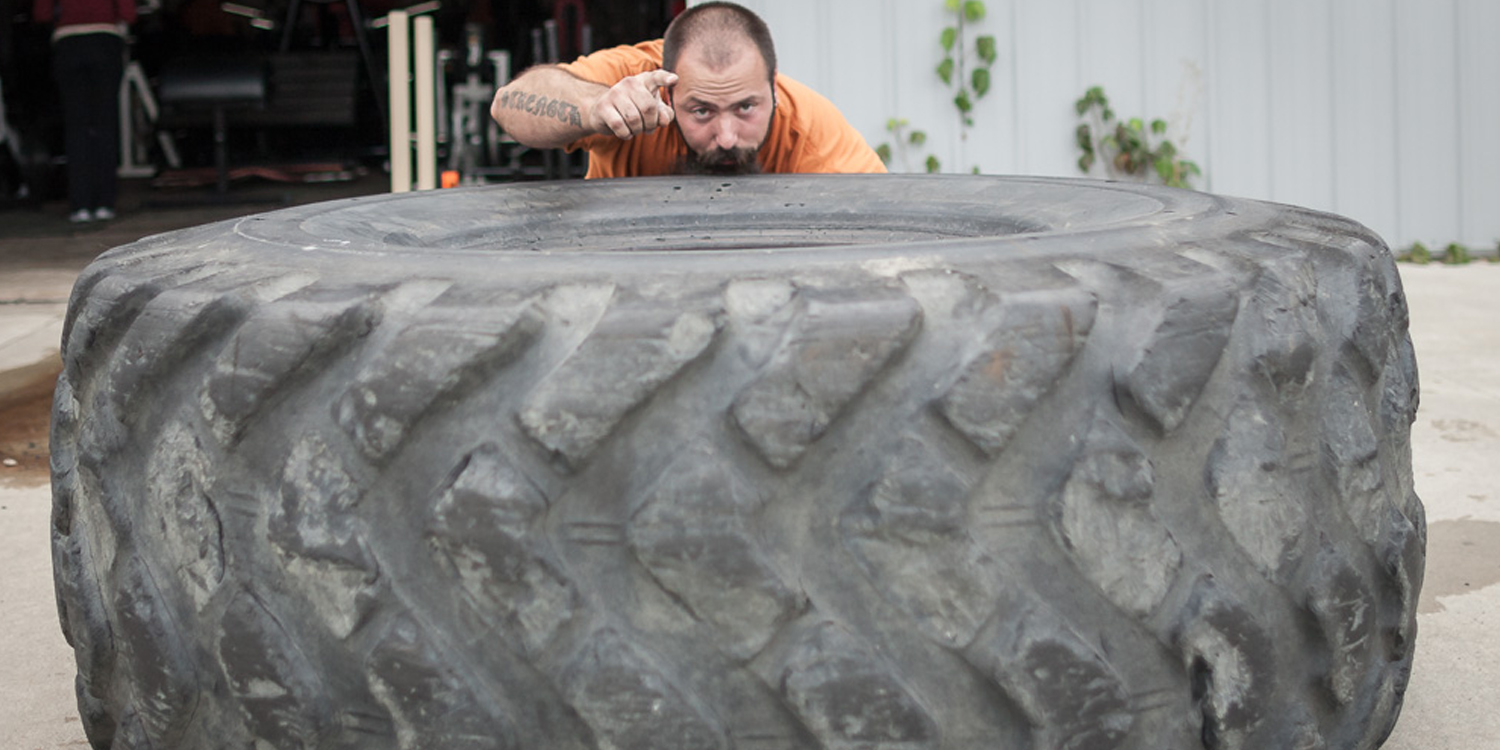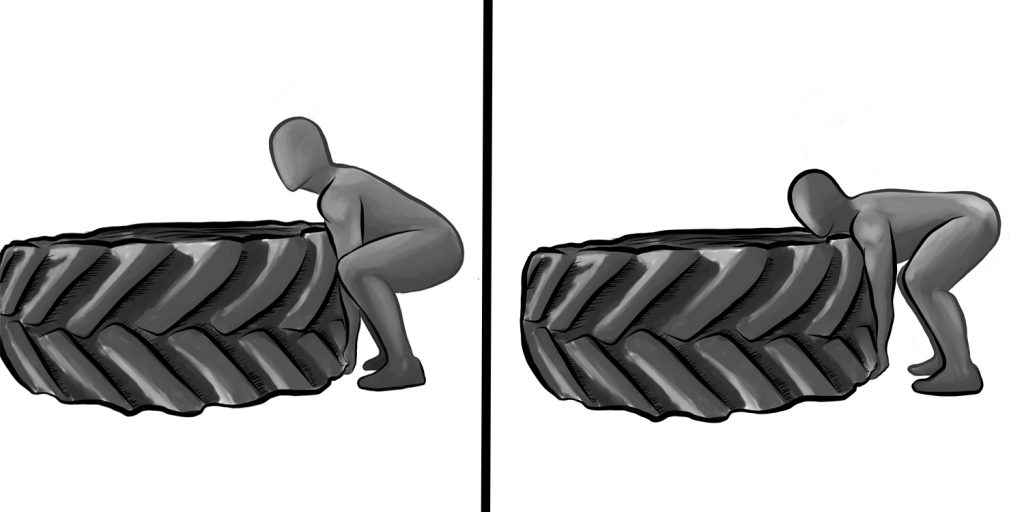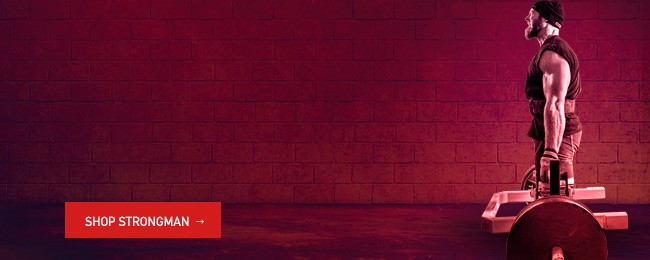
The tire flip has become a staple exercise of aspiring tough guys. Something is appealing about it from a primal level when flipping over a huge bunch of rubber. Unsurprisingly, the tire flip has made its way to the world of strength sports. Given its rugged nature, it can only be truly at home in one discipline: strongman.
Why is it, then, that the tire flip seems to be the least liked amongst strongmen? Perhaps science has the answer, more specifically, a questionnaire administered to 213 strongmen (1). It was found that the big boys consider the tire flip as the most dangerous exercise, followed by the yoke walk and stone lifting. The researchers prodded into which body part was the most injured in each exercise. The results for the tire flip? Biceps, overwhelmingly. No other strongman exercise in the analysis came close to the number of bicep injuries reported for the tire flip, except for stone lifting.
Tire Flips Kill the Biceps
Perhaps the results mentioned above give us a clue as to why the tire flip is so loathed. But science confirms what any seasoned strongman could tell you: tire flips kill the biceps. They put powerful people out of commission for months and sometimes on their way to the surgery room. After all that, dubbing the tire flip as a “giant killer” isn’t so out there. Bicep tears can throw years of planning out of the window or end a career for good. You don’t need science to confirm that. Just ask around. We all have had scares with that extra heavy deadlift single we shouldn’t have attempted. Yes, I am looking at all of you. We can’t help it.
However, strongman athletes are not known for running away from challenges. Another study (2) found that a whopping 82 percent of the strongmen questioned had reported including the tire flip in their training practice. Given the popularity of the exercise, despite their injury potential, is there something that could be done to lessen the risk? Is it really justified?
Strongman training is notorious for its unforgiving, tough-as-nails nature. Anything goes in the exercise selection, and as a professional strongman competitor, you may find yourself having to heave a tree, push a truck, or hold a hammer for time. As such, strongman training must prepare you for anything you may find at the arena. But there’s little you can do to bulletproof your biceps against tears. True, strong biceps can take more punishment than weak ones, but the problem lies in how stronger can the biceps become in the first place. Especially when compared to other muscle groups that take the brunt of the work in strongman training.
A Quick Look at the Tire Flip
Let’s first have a look at the exercise for those who are not familiar with it. The tire flip, as most strongman training exercises, looks deceptively simple. Wedge yourself against a giant tire, lift it off the ground, keep walking, done. Of course, the devil is in the details.

Firstly, there isn’t a single universal way of performing a tire flip. This has already been described (3), and any strongman athlete or coach worth their salt can confirm it to you. The tire can be flipped with an emphasis on the leg push (see picture to the left) or on the back pull (see picture to the right). The tire flip is not that different from the deadlift. The phenomenon of “squatting” the deadlift is well known, so it makes perfect sense for it to appear here too. There is one big caveat, though. A barbell allows the deadlift to be a highly precise exercise in terms of center of gravity alignment. In the deadlift, everything has the potential to be optimized, so to speak, from a biomechanical point of view.
Now compare the clean efficiency of a barbell with a tire. It refuses to let you sink your hands underneath. The rubber is scraping your shoulders. Your arms are bent at an awkward angle. The tire forces you to crouch too much or too little, and leverage is far from good... Obviously, that is what has made the tire flip a strongman-worthy exercise.
Getting back to the tire flip, what makes it so dangerous? We have already mentioned some of the prime movers in the lift: the legs and the back. As you know, those areas house some of the strongest and most powerful muscles in the human body. Now compare them with the relatively small biceps. Even if you train your biceps like crazy, they will never achieve the same strength levels as the quads.
In the tire flip and many other strongman exercises, the biceps are not prime movers. They are just not built for the task. Trying to curl the tire is one of the worst mistakes you could make. But when the tire starts feeling heavy and you focus on flipping the damn thing, you may give in and unconsciously engage your biceps beyond what is safe.
Biceps Position and Movement
In my opinion, the most important contributing factor when accounting for biceps injuries in the tire flip is engaging the biceps dynamically. That is, flexing the arm against the tire’s weight as if curling it. The biceps hold well when stretched statically, as in a mixed-grip deadlift, but flex the arm a bit under a heavy load and all hell breaks loose. That’s when bicep tears take place. Dynamic engagement of the biceps, aka flexing the arm, isn’t advised when lifting heavy weights. Again, the deadlift is using some of the powerhouse muscles of the body as prime movers, and we can’t expect the biceps to be able to replicate their strength. This seems fairly evident in the deadlift, but due to the similarities between the two exercises, it also holds true for the tire flip.
The tire flip has an additional problem when compared to a barbell deadlift: the odd shape of the tire. A giant tire isn’t made for you to flip it. You will frequently find that there is no way of wedging yourself against the tire without using a setup that is far from desirable. Tall strongmen will find that they have to lean forward too much. Short strongmen will find that their wedge loses its strength and becomes more of a squatting motion (look again at the picture to the left). It’s usually the case that the tire with an optimum height is too heavy for a beginner, but progressing from one tire to another becomes difficult when the weight jumps in-between tires are wild. The different heights call for technical adjustments.
If we go back to our previous deadlift example, it seems like keeping the arms straight would be a safe option in the tire flip. But sometimes that isn’t possible due to the shape of the tire. Furthermore, keeping the arms straight throughout the whole lift-off of the tire will call for extra power so the flip “flies” for a moment and allows for the lifter’s arms to be repositioned. Of course, this need for extra power is part of the prize in this exercise, but is it the safest way to develop a powerful hip-hinge? Strongman and traditional training have no shortage of exercises that work this same movement pattern, in safer ways than the tire flip.
Pros and Cons of the Tire Flip
If you're not discouraged yet, find a good coach that can guide you properly and steer you clear from injury. Ask yourself again if the pros outweigh the cons. Let’s have a hard look at the pros and cons of the tire flip.
PROS
- The tire flip works hip-hinge mechanics in an awkward position. Experience shows that the transference from awkward exercises to more efficient ones is usually favorable.
- If you can lift an awkward load, you should be able to lift more in a more comfortable exercise. Such as using a barbell, as opposed to a tire that doesn’t even have handles for you to grab.
- A tire flip could be a good plateau-busting tool if you are willing to take the risk of bicep tears.
- The tire flip can be fun if you are into that kind of thing.
CONS
- The biceps are placed in a high-risk position during the tire flip.
- Problems with standardization and sourcing of tires: uneven weight jumps in-between tires, odd-shapes, varying heights that force you to adjust the technique...
- Some tires aren’t lifter-friendly. For example, if a tire is flat, good luck getting your hands under it. Another example: some tires are just too squishy and refuse to move as a single unit. The exercise then becomes a weird choreography where part of the tire is lifted. All while the rest of it refuses to leave the ground.
Frankly, I couldn’t think of any more pros, or better ones, for the tire flip when coming up with these lists. And even for those pros, there are far better options other than the tire flip. Sure, flipping a giant tire looks impressive and makes you feel powerful, but at what cost? Odd objects indeed induce training adaptations. Precisely because they are difficult to lift, they challenge your body in unusual ways. Remember, there’s a point where the tradeoff between injury risk and benefit is not worth it.
As you can see, the tire flip presents serious tradeoffs for the benefits it may provide. It’s up to each person to gauge if the injury risk is worth it. I know what my veteran strongmen friends do. They won’t touch a tire with a foot-long pole. On the rare occasions they do, they use a weight that is way under their limit. Perhaps you would be better off finding something a bit less awkward that allows you to lift a lot more weight or working that hip hinge with a yoke, log cleans, or our beloved deadlift. Got a tire already but aren’t feeling like flipping it? No problem, it still has plenty of uses and can be used together with a hammer for a wonderful fat-burning exercise. There are more exercises to put that tire to good use, other than the tire flip.
References
- Winwood PW, Hume PA, Cronin JB, Keogh JWL. Retrospective injury epidemiology of strongman athletes. J Strength Cond Res. 2014;28(1):28–42.
- Winwood PW, Keogh JWL, Harri NK. The strength and conditioning practices of strongman competitors. J Strength Cond Res. 2011;25(11):3118–28.
- Waller M, Piper T, Townsend R. Strongman Events and Strength and Conditioning Programs. Strength Cond J. 2003;25(5):44–52.
Eduardo Moya, CSCS, CrossFit Level 2 Trainer, is a strength and conditioning coach specializing in strongman and powerlifting. He founded and operated the first University CrossFit Club Affiliate in Spain. Eduardo is a frequent lecturer at strength training seminars. His trademark signature is making science approachable while helping to bridge the gaps between performance and health. At the moment, he is finishing two university degrees: sports sciences and physiotherapy.











1 Comment